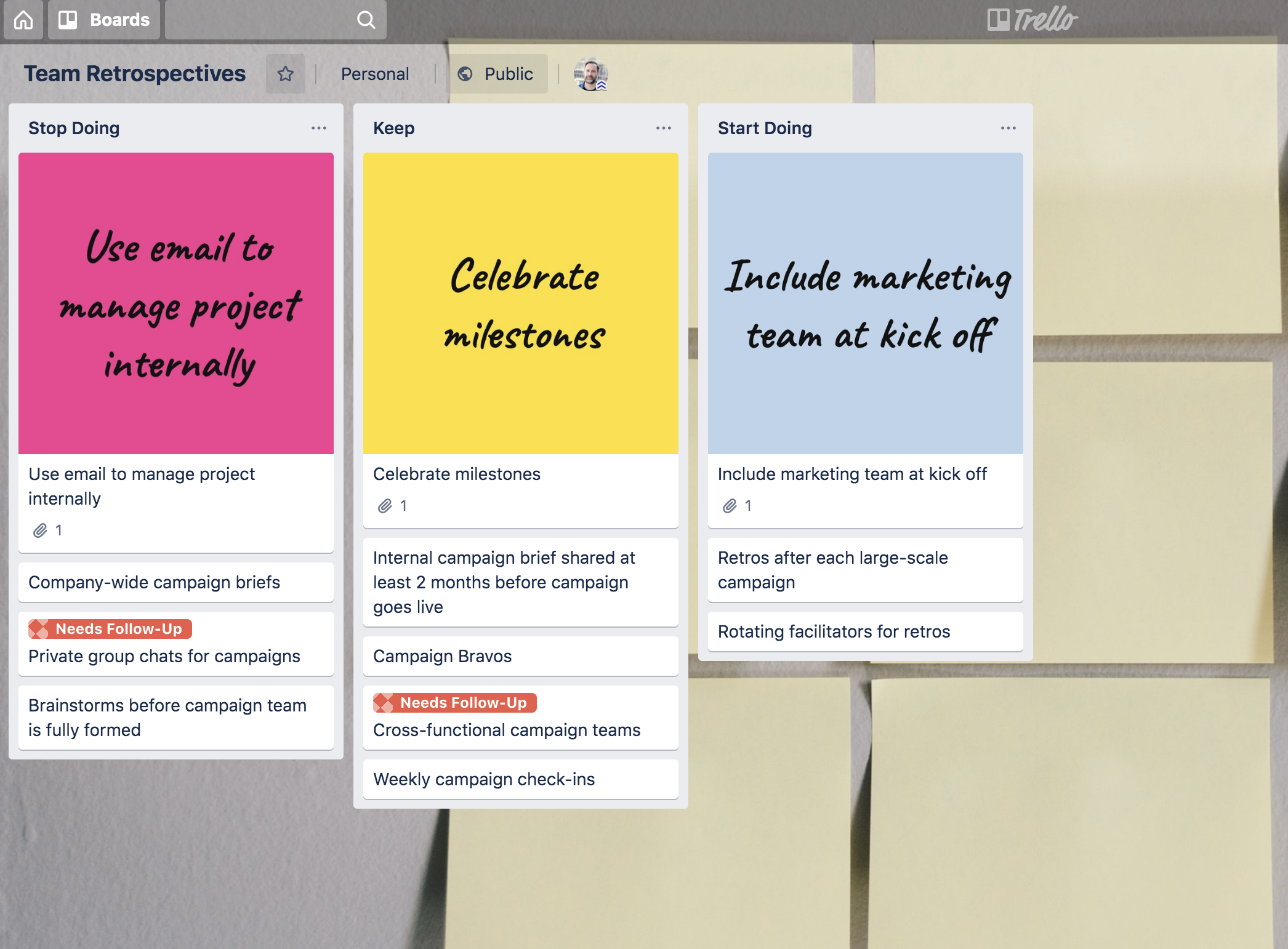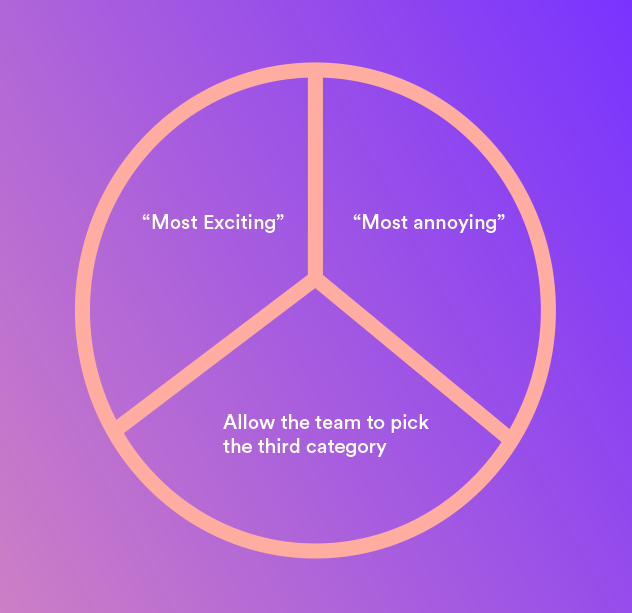In the software development space, shipping fast and in a continuously iterative process is only half of the puzzle.
There is no point in engaging in agile software development if you don’t also incorporate retrospectives into your process. If you haven’t participated in a retrospective yet, it’s definitely time to start.
What Are Retrospectives?
Retrospectives are essentially a post-mortem meeting with everyone involved on a project to discuss what worked, what didn’t, and to agree on actionable ways to improve for the next time.
Retrospectives are commonly used by agile software development teams to:
- Highlight opportunities for change
- Generate meaningful process improvements
- Move the team in the intended direction
Overall, they’re a great way to be able to look back and see if problems that surfaced in the past have been resolved. Unsettled issues are known to impact multiple teams and can mean big losses for the business.
Despite the common application of retrospectives in the realm of agile software development, all teams can take advantage of them depending on the scope.
If it’s a development team, for instance, that would include everyone who is designing, building, and testing the product. If this was your growth team, however, the retrospective could include marketing, business stakeholders, agency support, analytics teams, design, etc.
So whether you organize your work around sprints and releases, or more ongoing areas of work such as support, services, and projects, any team can apply retros.
By making retrospective meetings accessible to everyone, from operational and strategic managers, to members that support only smaller portions of the project, all areas have the potential to benefit. Each individual has a different point of view that will make your retrospective more valuable.
Let’s illustrate some examples of what you can actually learn from retrospectives and better identify the good and bad (and sometimes ugly) in a project and, ultimately, be able to manage the outcome.
- Did you commit to too much work for your entire team to complete?
- Was there insufficient communication during the time between retros?
- Did some members of the team not take into account the needs of other members?
As you can see, a retrospective provides a better understanding of the internal workings of the entire team.
On the other hand, this is also a time for team members who don’t normally interact with customers, such as engineers or developers, to become aware of the customer’s needs and nuances.
Who could possibly say no to managing such valuable information?
Running (Actually) Fun & Productive Retrospectives
To run retrospectives you should involve the full team in order to foster greater collaboration between all parties involved. Introducing elements of spontaneity and fun into retrospectives can help keep teams interested. Plus, who doesn’t like a party?
Retrospective meetings can be divided into a few steps to help teams communicate better. Here’s how you can divide your retrospectives into different steps. Let’s look at a few ways we can set a process that not only gets us to where we want, but is also enjoyable for all participants.
The Warm-Up
Open the meeting with one of these warm-up activities to get everyone excited in less than 5 minutes. Faster than popping some popcorn! If you create a safe space for everyone involved, you will be rewarded with higher participation and avoid unfocused team members, a lack of buy-in, or poor outcome.
Activity 1: ESVP – Explorer, Shopper, Vacationer, Prisoner
Start by asking each participant to anonymously report their attitude toward the retrospective meeting. It is an anonymous way to find out if people really want to be there or not. Let everyone identify as one of the four:
- Explorers want to learn as much as they can about the project, product release, or iteration.
- Shoppers will examine all the information and will be delighted if they can walk away with one actionable idea.
- Vacationers are comfortable with the idea of getting away from their desk, but aren’t really there for the meeting.
- Prisoners would rather be doing something else.
Once you’ve done this, you can have a conversation about how to continue with the whole group. For example, if many of the members chose Prisoner, you might want to ask the group if they would prefer to reschedule because they’ve got too many other things on their plate at the moment. Retros are always more effective with more engaged participants.
Activity 2: One-word exercise
Pose a simple question to the team to set the stage. Some examples are:
- What kind of emotions do you feel from the last project, release, or iteration you worked on? Let the team choose one: happiness, frustration, sadness, pride, etc.
- How are you feeling today? Rate it from 1 to 10.

Gather Data And Get A Different Retrospective Every Time
Brainstorm and gather data through activities to collect as much information as possible in a short amount of time. Identify the topics that the team would like to talk about.
Generate insights through activities that will get to the root cause of the problem. Decide what to do with what has been discussed and identify one or more actionable steps that the team can take following the meeting.
For the following exercises using sticky notes, whiteboards, or a digital tool like Trello, can be very helpful to identify the actions to take on together as a team to improve. If you haven’t tried it yet, the new Trello integration for the Post-it® App is the perfect pairing of analog and digital tools.
Activity 1: Stop – Keep – Start (SKS)
This simple process allows us to explore and ask members of the team what we should stop (S), keep (K), and start (S) doing.
- Stop — What hasn’t gone well, and what do we want to stop doing?
- Keep — What is going well, what have we still not been able to draw a conclusion about, and what should we keep doing?
- Start — Have we identified something that we should start doing but we haven’t yet?
Trello Board
- Make a Trello list for Start, Stop, and Keep.
- Get team members to add to the lists in the week prior to the retrospective.
- Run through each card during the meeting to discuss and cover all items.

Activity 2: Academy Awards Retrospective
Like all the other proposed retrospectives, the objective of this exercise is to generate as much conversation as possible. However, this one can really help change up the dynamic by designating what has worked best and vote for the winner on the following categories:
- “Best” (or “Most” exciting, educative, collaborative)
- Most annoying (of difficult, incomplete, sloppy)
- Most complex / Most Exciting. (Or let the team define the category)
Set up the game by drawing a 3 parts starfish on an easel sheet and write down 2 category titles. Leave the third blank and spend 5 minutes to identify the missing category.

Now, give the team 10 minutes to nominate and make this part of the collaborative process. Then ask the team to vote on the three categories. End the group exercise with a 20-minute discussion of why the selected items are the “best” in their category.
Activity 3: The Speedboat Retro
This exercise goes beyond the typical questions and helps the team to gain insight on things they could not otherwise get if they didn’t go beyond the typical questions. Let’s look at these tips:
- Island/Vision: Set a goal for the mid/long-term on the project. This idea seems obvious but sometimes gets lost in everyday tasks.
- Wind/What helps the team: What helps it get better, faster, and more mature. These are the positive elements.
- Anchor/Things to improve: What is holding the team back: impediments, things that went wrong, or aspects the team doesn’t want to repeat again.
- The Rocks/Risks: Things that should be analyzed as they might become issues in the future.

Reflect On Your Retro
Close the retrospective by evaluating what has been discussed and checking for opportunities to improve your next retro meeting. Based on the results of the retrospective, every team should have its own plan to revamp and improve the techniques.
There are always opportunities for refinement, even if your team has worked together for a long time.
Activity 1: One-word question
- What do you take away from this Retro: Solutions to issues, nothing, improvements, new ideas, or loss of time?
- Happiness metric: Each member rates the Retro on a 1 to 5 scale.
- Make a drawing: Each person makes a drawing and shares it with the team.
Fall Back In Love With Your Retrospectives
These are just a few suggestions of ways to run Retrospectives. There are countless other techniques that you can use to correct and improve your performance. Set a cadence for your meetings as you see fit. For example, periodically every 2 weeks, at specific stages of a project, or after accomplishing larger milestones.
Keeping the regular cadence of the event means that you can use always use a part of the exercise to make a plan to improve the next one with a healthy feedback funnel.
If you are interested in more techniques for coaches, scrum masters, and other facilitators, this one-stop retrospective inspiration Trello board is a must.
Happy retro!
Next: From Ideas To Action: How To Turn Post-it Notes Into Trello Cards







































